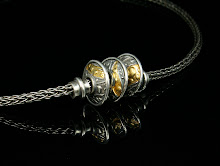
I'm really looking forward to the start of classes this fall. I teach three metal clay classes every week (ongoing, fall through spring). This summer, I took time off to recharge my creative batteries (and begged forgiveness from the students who objected)... even skipped the show circuit and just did gallery work. Summer's been great for creative time. The school year is very hectic, so it was nice to slow down and have more family time too.
 I played with COPPR and BRONZ clays, did a lot of enamel testing on the COPPRclay, wrote an article, and created some new pieces. The best part is that I have some new tricks to share with my students...
I played with COPPR and BRONZ clays, did a lot of enamel testing on the COPPRclay, wrote an article, and created some new pieces. The best part is that I have some new tricks to share with my students...It will be great to see returning students and meet eager new ones. I love to watch the progression of skill (and level of work) as people grow more competent and confident. And there's nothing like the enthusiasm of a new student just starting out in metal clay-it's such amazing material. I particularly enjoy addressing the challenges that the advanced students encounter. Problem-solving is great fun. Part of what attracted me to jewelry and metals more than 30 years ago, is that intersection of design and engineering.
Teaching metal clay came to me almost by chance. Many years ago, a friend who manages programs for an organization was looking for more art offerings. I'd been telling her about metal clay and she asked if I'd be willing to teach a class. I agreed, and I was hooked. It wasn't that I hadn't taught art before-in volunteer ways-with Girl Scouting and through the schools. But this time, it was teaching my medium in such a focused way-to eager adult learners, that opened a new door. It's funny, because art education was suggested to me when I was in college, but a bad experience with an opinionated (and probably burned out) high school art teacher scared me away from that.
So why do we teach? I'll make a guess that it's not for the money... in any area of teaching. For me it's the whole lighting a spark thing. I think learning is contagious... and when people get excited about what they're doing and learning, it's just awesome. There's great satisfaction in helping someone find a way to express themselves creatively. Someone did that for me once upon a time :) -which I appreciate. There's also tremendous satisfaction in seeing people succeed and be happy about what they're doing. And teachers like to share-we can't help it. Some days it seems like all I really want to do is tell you about making jewelry with metal clay and truly hope you'll to like it as much as I do. I had lunch today with a couple of metalsmith friends and caught myself enthusiastically touting the merits of metal clay (they've heard this before...).
People sometimes wonder if working artists who teach feel threatened by their students' success. I can't imagine if we were, that we'd be very effective teachers. The whole reason we share our knowledge and help people express themselves, is so they WILL be successful. If a student finds his or her voice and excels, then I've done my job. I wish them well.
I'll post some more enamel results soon, but I had take a break to get organized for classes. And in doing so, I realized how much I was looking forward to the start of the fall session. If you have a minute, it would be fun to hear what motivates other teachers and what students like about taking classes.











